This CE Center article is no longer eligible for receiving credits.
People experience buildings not just with their eyesight, but with all their senses including the sense of hearing. That means the quality of their experience is directly related to the quality of the acoustic design of a space they encounter. If there are too many surfaces that create echoes, then speech is frustratingly difficult to understand. If sound passes from one interior space to another, then privacy, comfort, and wellness are compromised. If noise enters from outside the building or from mechanical equipment, then the overall quality of the indoor environment suffers. It has been well documented by numerous sources that poor acoustics or exposure to noise in buildings negatively impacts the ability of people to concentrate, be productive, learn, converse, or heal. Further, those exposed to these conditions over the long term can see a deterioration in their health related to physical and psychological degradation. This course focuses on how the design of buildings can directly and intentionally address these acoustical concerns. It looks at some specific strategies related to common interior surfaces including walls and ceilings as well as some special concerns related to doors, architectural louvers, and healthcare cubicles. Overall, different strategies and techniques are explored to create positive indoor environments with desirable acoustical results.

Photo courtesy of Rockfon
Acoustical experiences in buildings are directly influenced by the materials used, including ceilings, walls, doors, and other types of enclosures.
Acoustics Overview
The study of acoustics is defined as the branch of physics concerned with the properties of sound. That means that there are basic scientific principles that have been studied, observed, documented, tested, and ratified by specialists for decades and even centuries. The application of this science is what design professionals often become involved in since all building interiors will be subject to sound which acts in accordance with those scientific characteristics. By understanding how sound acts upon or reacts against walls, ceilings, doors, and other parts of buildings, then the behavior of that sound in a building is more predictable.
Acoustics have garnered more attention recently because of numerous studies, surveys, and other efforts that look at the impact on people of good and bad acoustical design in buildings. Many national building design standards contain a variety of acoustics requirements that include attention to the way that sound is absorbed inside rooms, how to block sound from passing between rooms or between inside and outside, and the control of background noise such as from mechanical equipment. Some of the metrics that are found in different standards are shown in the following chart and discussed in the subsequent paragraphs.
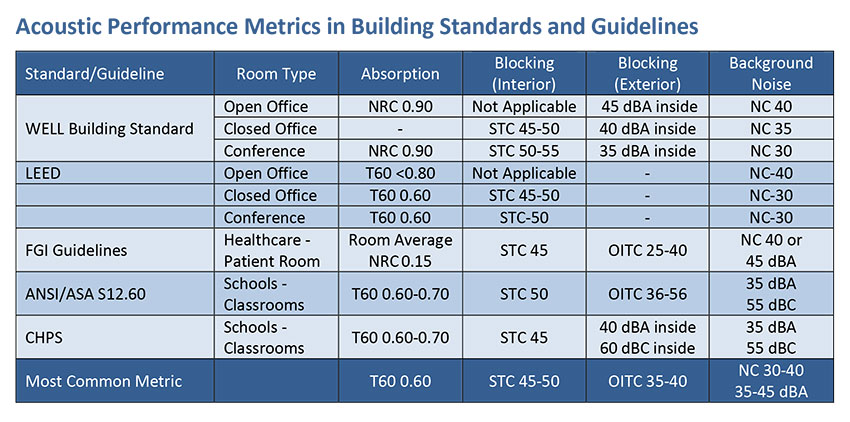
Image courtesy of Rockfon
Table 1

Photo courtesy of Rockfon
Using high-performance ceiling panels made of stone wool or perforated metal with NRC ratings of at least 0.90 can lead to compliance with the required maximum reverberation times even when there are no other sound-absorbing surfaces in the room.
Sound Absorption
The building standards cited typically prescribe minimum sound absorption requirements in terms of either minimum ceiling Noise Reduction Coefficient (NRC) or maximum sound reverberation time (T). This absorption is required so that speech is intelligible in enclosed rooms used for assembly/ communication (such as classrooms). It is also needed so that auditory privacy is achieved in open spaces (like open offices) and between enclosed spaces (patient recovery areas). The standards typically require minimum ceiling NRC to be a very absorptive 0.90 in open and noisy (high occupancy) spaces and in patient care areas or medication safety zones inside healthcare buildings. They require 0.80 or higher in medium to large rooms where people gather/assemble to communicate (classrooms, meeting rooms, training rooms, lecture halls). They only permit low NRC of 0.70-0.75 in small private rooms such as private offices. NRC below 0.70 is not permitted by the standards because it is seen as detrimental to wellness in humans.
Sound Isolation
The building standards typically have minimum sound isolation requirements between adjacent rooms (horizontal and vertical adjacency) in terms of Sound Transmission Class (STC). This isolation is needed so that noise from adjacent rooms/floors does not annoy people or interfere with what they are trying to do. It also provides privacy or confidentiality when sensitive information is being discussed. The standards typically require STC 50 or greater for the floor-ceiling assembly located between two vertically adjacent rooms. STC 45 for the partitions is the most widely used performance level between two horizontally adjacent rooms.
The use of STC indicates that demising walls extend vertically from floor to floor and all penetrations are sealed airtight. Relying on any modular acoustic ceiling alone, for example, when the wall stops at the ceiling and does not completely block off the plenum, cannot provide the levels of isolation required by the standards and guidelines. A modular, acoustic ceiling does not have enough mass to block sound. The lights, air devices, and other elements also result in noise leaks, worsening performance. For these reasons, CAC (Ceiling Attenuation Class) is not a part of most standards and guidelines and may no longer be necessary in project specifications.
Background Sound
The building standards typically have maximum background sound level requirements in terms of Noise Criterion (NC). Excessive background noise can interfere with speech intelligibility which can cause stress, fatigue, and discomfort. The standards typically require that the background noise does not exceed NC 30 (e.g., conference rooms), NC 35 (e.g., classrooms) or NC 40 (e.g., lobbies, open offices).
Stone Wool Acoustic Ceilings
Acoustic ceilings are one of the few building products and systems that contribute to compliance with multiple performance categories including sound absorption, sound isolation and background noise levels. Therefore, it is easy to see why the use of acoustic ceilings is a design decision that produces a high benefit relative to their low cost. The main acoustic purpose and strength of suspended ceilings is sound absorption. Additional absorption on the walls and floor may only be required if the ceiling does not provide enough sound absorption; for example, when the NRC is less than 0.70, or when parts of the ceiling are intentionally left sound reflective to project sound.
While different materials are used to make acoustic ceiling products, not all ceiling panels can meet the high NRC requirements in the standards. High performance choices use stone wool for the core of the acoustic ceiling panels or position stone wool absorptive backers on top of perforated metal ceilings. These acoustic ceilings suspended inside enclosed rooms and throughout open spaces are a cost-effective, easy, and efficient way to comply with the absorption requirements in the standards. An architect or specifier only needs to ensure that the manufacturer’s NRC rating from their data sheet meets or exceeds the minimum NRC in the applicable standard(s). If the absorption requirement is given in Reverberation Time, then the NRC is entered into a simple equation with the room’s volume and surface areas to check compliance.

Photo courtesy of Rockfon
In open spaces, where sound blocking between rooms is not important, using ceiling panels made of stone wool or perforated metal with a sound absorbing backer and with a NRC rating of 0.90 or higher can lead to compliance with maximum mechanical system and exterior noise levels by absorbing noise that has already entered the room.
People experience buildings not just with their eyesight, but with all their senses including the sense of hearing. That means the quality of their experience is directly related to the quality of the acoustic design of a space they encounter. If there are too many surfaces that create echoes, then speech is frustratingly difficult to understand. If sound passes from one interior space to another, then privacy, comfort, and wellness are compromised. If noise enters from outside the building or from mechanical equipment, then the overall quality of the indoor environment suffers. It has been well documented by numerous sources that poor acoustics or exposure to noise in buildings negatively impacts the ability of people to concentrate, be productive, learn, converse, or heal. Further, those exposed to these conditions over the long term can see a deterioration in their health related to physical and psychological degradation. This course focuses on how the design of buildings can directly and intentionally address these acoustical concerns. It looks at some specific strategies related to common interior surfaces including walls and ceilings as well as some special concerns related to doors, architectural louvers, and healthcare cubicles. Overall, different strategies and techniques are explored to create positive indoor environments with desirable acoustical results.

Photo courtesy of Rockfon
Acoustical experiences in buildings are directly influenced by the materials used, including ceilings, walls, doors, and other types of enclosures.
Acoustics Overview
The study of acoustics is defined as the branch of physics concerned with the properties of sound. That means that there are basic scientific principles that have been studied, observed, documented, tested, and ratified by specialists for decades and even centuries. The application of this science is what design professionals often become involved in since all building interiors will be subject to sound which acts in accordance with those scientific characteristics. By understanding how sound acts upon or reacts against walls, ceilings, doors, and other parts of buildings, then the behavior of that sound in a building is more predictable.
Acoustics have garnered more attention recently because of numerous studies, surveys, and other efforts that look at the impact on people of good and bad acoustical design in buildings. Many national building design standards contain a variety of acoustics requirements that include attention to the way that sound is absorbed inside rooms, how to block sound from passing between rooms or between inside and outside, and the control of background noise such as from mechanical equipment. Some of the metrics that are found in different standards are shown in the following chart and discussed in the subsequent paragraphs.

Image courtesy of Rockfon
Table 1

Photo courtesy of Rockfon
Using high-performance ceiling panels made of stone wool or perforated metal with NRC ratings of at least 0.90 can lead to compliance with the required maximum reverberation times even when there are no other sound-absorbing surfaces in the room.
Sound Absorption
The building standards cited typically prescribe minimum sound absorption requirements in terms of either minimum ceiling Noise Reduction Coefficient (NRC) or maximum sound reverberation time (T). This absorption is required so that speech is intelligible in enclosed rooms used for assembly/ communication (such as classrooms). It is also needed so that auditory privacy is achieved in open spaces (like open offices) and between enclosed spaces (patient recovery areas). The standards typically require minimum ceiling NRC to be a very absorptive 0.90 in open and noisy (high occupancy) spaces and in patient care areas or medication safety zones inside healthcare buildings. They require 0.80 or higher in medium to large rooms where people gather/assemble to communicate (classrooms, meeting rooms, training rooms, lecture halls). They only permit low NRC of 0.70-0.75 in small private rooms such as private offices. NRC below 0.70 is not permitted by the standards because it is seen as detrimental to wellness in humans.
Sound Isolation
The building standards typically have minimum sound isolation requirements between adjacent rooms (horizontal and vertical adjacency) in terms of Sound Transmission Class (STC). This isolation is needed so that noise from adjacent rooms/floors does not annoy people or interfere with what they are trying to do. It also provides privacy or confidentiality when sensitive information is being discussed. The standards typically require STC 50 or greater for the floor-ceiling assembly located between two vertically adjacent rooms. STC 45 for the partitions is the most widely used performance level between two horizontally adjacent rooms.
The use of STC indicates that demising walls extend vertically from floor to floor and all penetrations are sealed airtight. Relying on any modular acoustic ceiling alone, for example, when the wall stops at the ceiling and does not completely block off the plenum, cannot provide the levels of isolation required by the standards and guidelines. A modular, acoustic ceiling does not have enough mass to block sound. The lights, air devices, and other elements also result in noise leaks, worsening performance. For these reasons, CAC (Ceiling Attenuation Class) is not a part of most standards and guidelines and may no longer be necessary in project specifications.
Background Sound
The building standards typically have maximum background sound level requirements in terms of Noise Criterion (NC). Excessive background noise can interfere with speech intelligibility which can cause stress, fatigue, and discomfort. The standards typically require that the background noise does not exceed NC 30 (e.g., conference rooms), NC 35 (e.g., classrooms) or NC 40 (e.g., lobbies, open offices).
Stone Wool Acoustic Ceilings
Acoustic ceilings are one of the few building products and systems that contribute to compliance with multiple performance categories including sound absorption, sound isolation and background noise levels. Therefore, it is easy to see why the use of acoustic ceilings is a design decision that produces a high benefit relative to their low cost. The main acoustic purpose and strength of suspended ceilings is sound absorption. Additional absorption on the walls and floor may only be required if the ceiling does not provide enough sound absorption; for example, when the NRC is less than 0.70, or when parts of the ceiling are intentionally left sound reflective to project sound.
While different materials are used to make acoustic ceiling products, not all ceiling panels can meet the high NRC requirements in the standards. High performance choices use stone wool for the core of the acoustic ceiling panels or position stone wool absorptive backers on top of perforated metal ceilings. These acoustic ceilings suspended inside enclosed rooms and throughout open spaces are a cost-effective, easy, and efficient way to comply with the absorption requirements in the standards. An architect or specifier only needs to ensure that the manufacturer’s NRC rating from their data sheet meets or exceeds the minimum NRC in the applicable standard(s). If the absorption requirement is given in Reverberation Time, then the NRC is entered into a simple equation with the room’s volume and surface areas to check compliance.

Photo courtesy of Rockfon
In open spaces, where sound blocking between rooms is not important, using ceiling panels made of stone wool or perforated metal with a sound absorbing backer and with a NRC rating of 0.90 or higher can lead to compliance with maximum mechanical system and exterior noise levels by absorbing noise that has already entered the room.
Sound Reducing Gypsum Panels
Interior partitions are routinely constructed of metal or wood framing with gypsum panels (drywall) on both sides. With the increased focus on acoustics, human health, and work productivity, higher STC ratings are more routinely specified for these interior partitions. To meet the higher STC ratings, gypsum board partitions require enhancements beyond what conventional gypsum panels provide. Traditionally, these enhancements include adding sound insulation between the studs, using thicker or multiple layers of gypsum panels, or using resilient channels to decouple the drywall from the studs, all of which require additional time and extra cost. In the case of thicker or multiple layers of gypsum panels, the usable square footage of space is decreased, and the increased depth of the partition can impact detail coordination, particularly around door openings and utility boxes.
Design professionals seeking to balance acoustical performance, wall thickness, and cost are finding that there are options available using sound reducing gypsum board. Such products are made as gypsum panels but use a technique known as constrained layer damping (CLD). Products using this technique achieve high sound attenuation and fire resistance in one panel using less space, less material, and less labor than other acoustical treatments. CLD panels are manufactured with a viscoelastic polymer central layer that allows thin gypsum outer layers to independently shear, thus dissipating the acoustic energy of sound waves. This results in less audible energy passing through the CLD panels.
Essentially, constrained-layer damping is a vibration isolation technique that was originally developed for naval vessels and airplane fuselages. CLD requires the application of materials that are viscoelastic and can deform easily when stressed and then return back into their original form. Sound reducing drywall products, through the application of such viscoelastic materials in gypsum panels, use shear-loading and vibration decay to reduce noise by 10 dB or more versus traditional treatments. Simply put, this makes it easier for the building partition to reduce vibration, which makes sound isolation much more efficient. Acoustic testing has been performed on a vast number of interior partitions using CLD panels to document the STC rating of assemblies. In many cases, the desired acoustic performance can be achieved with a single CLD layer without the need for multilayered gypsum panels, resilient channels, or supplemental products. This reduction in material and labor also decreases the chance for improper installation that can compromise performance.
CLD panels are easy to install and finish just like any standard gypsum panel product. Compared to multiple layers of drywall and resilient channel, CLD panels provide similar (if not better) STC results while reducing the amount of materials and labor needed, resulting in a lower installed cost compared to other acoustical treatments.
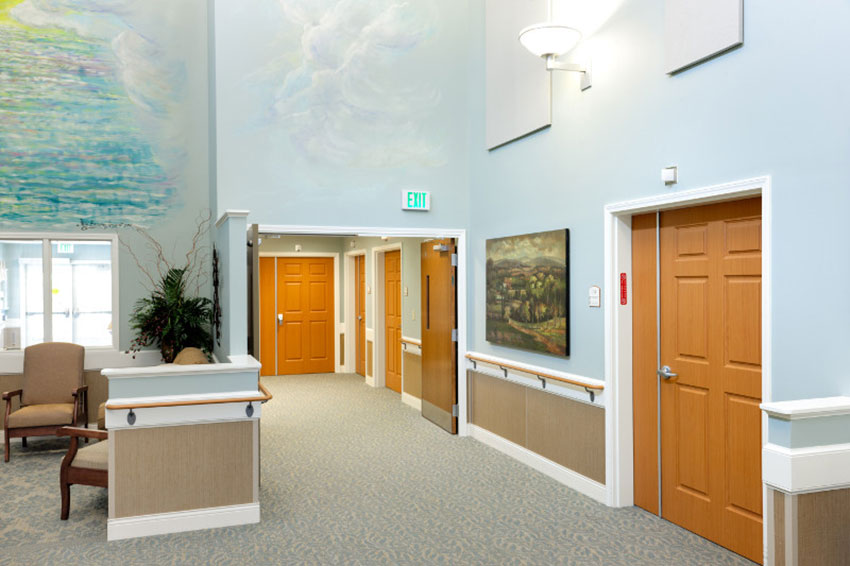
Photo courtesy of Construction Specialties, Inc.
If a door is placed in a partition with a designed sound rating, then that door should achieve the same sound rating as the wall for a continuous acoustical experience.
Acoustic Doors
While ceilings, walls, and floors are the usual focus of acoustical treatment in buildings, there are other surfaces and products that can directly contribute to the sound related experience of a space. A primary concern is with doors which are needed for access into and out of spaces, but if they are not also addressed acoustically, then unwanted sound transfer and noise will be present. It is important to note that in most commercial building applications, this means not only addressing the operable door itself but also the way that the door seals against the frame within the wall.
Sometimes, design professionals incorrectly assume that in order to make doors perform and achieve desired STC ratings, the aesthetics of the door or its ability to resist wear and impact has to be sacrificed. A review of the available options for acoustically enhanced doors quickly reveals that assumption is not correct. Rather, a range of interior doors are available that maintain the aesthetic options found on many other commercial door types and achieve very high levels of durability, all while still providing superior acoustic design and performance. Doors and frames are acoustically tested according to the same standards that other building components are. There are two common tests used by independent testing laboratories to determine acoustic performance. The first is ASTM E-90 “Standard Test Method for Laboratory Measurement of Airborne Sound Transmission Loss of Building Partitions and Elements.” The scope of this test method is intended to cover the laboratory measurement of airborne sound transmission loss of building partitions such as walls of all kinds, operable partitions, floor-ceiling assemblies, doors, windows, roofs, panels, and other space-dividing elements. The second is ASTM E413 “Classification for Rating Sound Insulation”. This classification covers methods of calculating single-number acoustical ratings (i.e., STC and related acoustical ratings) for laboratory and field measurements of sound attenuation in materials. Combined with ASTM E-90, this test is useful to determine how well an acoustic door reduces the amount of sound transfer between the two sides of the door.
Acoustic doors are tested as an assembly for both static tests of the doors and for an operable condition in a frame. Putty is used around the perimeter for the static test, so only the door unit is being assessed. For an operable test, gaskets, door bottoms, and sills are used. The operable rating provides a result closer to the installed condition of the door than the static test. Either way, the tests reveal the amount of sound transmission loss over a range of designated frequencies. It is important to specify that acoustic doors must be purchased with the gaskets that were used in testing in order to achieve the desired sound ratings.
Acoustic Ceiling Design
In terms of sound isolation, meeting the minimum STC 50 requirement for floor-ceiling assemblies (i.e., floor to floor vertical sound transmission) is impractical with a concrete structural slab alone. It would have to be too thick and massive, resulting in a higher slab cost and causing a ripple effect throughout the enlarged building structure and foundation. Instead, suspending an acoustic ceiling below the slab improves the floor-ceiling STC rating by 6-7 points. This takes the performance of a thinner and lighter-weight concrete floor slab in the low to mid 40s and boosts the performance over the STC 50 required in the standards. Most importantly, all ceiling panels in the market (stone wool, fiberglass, mineral fiber) offer the same improvement in STC to the floor slab. The architect/specifier does NOT need to select/specify ceiling panels of a certain material or weight or with a specific sound isolation rating. Acoustic ceilings are a great and cost-effective way to comply with the sound isolation requirements in the standards.
Finally, maximum background noise requirements are addressed by stone wool acoustic ceilings as well. Oftentimes, the noisiest devices affecting background (or ambient) sound levels are immediately above the ceiling in the plenum. These can be air terminal units (variable air volume boxes, fan-powered boxes, etc.) or other devices. The only element between the noise produced and the people in the room below is the suspended acoustic ceiling. To be effective at attenuating MEP plenum noise, an acoustic ceiling must:
- Be highly sound absorptive (high NRC) to absorb noise inside the plenum and inside the room below,
- Have a soft and malleable surface to conform to the irregularities in the supporting grid flanges and seal up potential noise leaks, and
- Be of sufficient weight (0.5 psf) to keep noise from passing through the ceiling panel itself.
Research and standards published by the American Society of Heating, Refrigeration, and Air-Conditioning Engineers (ASHRAE) and Air-Conditioning, Heating, and Refrigeration Institute (AHRI) state that all ceiling panels (fiberglass, stone wool, mineral fiber) perform the same in the frequencies of concern. One type of panel might weigh more, but another might absorb more or seal noise leaks along the grid more effectively. Therefore, architects do not need to specify ceiling panels of 1.0 psf or more or having a certain sound isolation rating when it comes to attenuating MEP plenum noise. Hence, acoustic ceilings are a great and cost-effective way to comply with the background sound requirements in these standards. For more detail and a simple 3-step design guide for controlling HVAC plenum noise with acoustic ceilings, refer to the HVAC Background Noise case study.
Gary Madaras, PhD, AAIA Acoustics Specialist with Rockfon has been addressing all these issues from the perspective of acoustical science for many years. He points out “With building acoustics, we seldom have a cost-effective design choice that helps us comply with so many different acoustics requirements in the standards. Implementing a stone wool or perforated metal acoustic ceiling leads to compliance with absorption, isolation, and background sound requirements.”
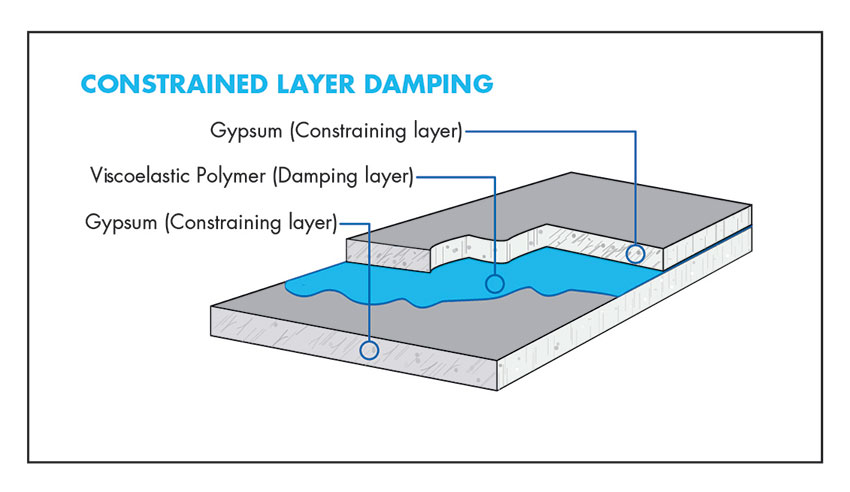
Image courtesy of PABCO® Gypsum
CLD gypsum panels use advanced viscoelastic polymers (damping layer) between two layers of gypsum (constraining layers) to reduce sound vibration in building partitions. When under vibration, the damping layer shears as the panel flexes.
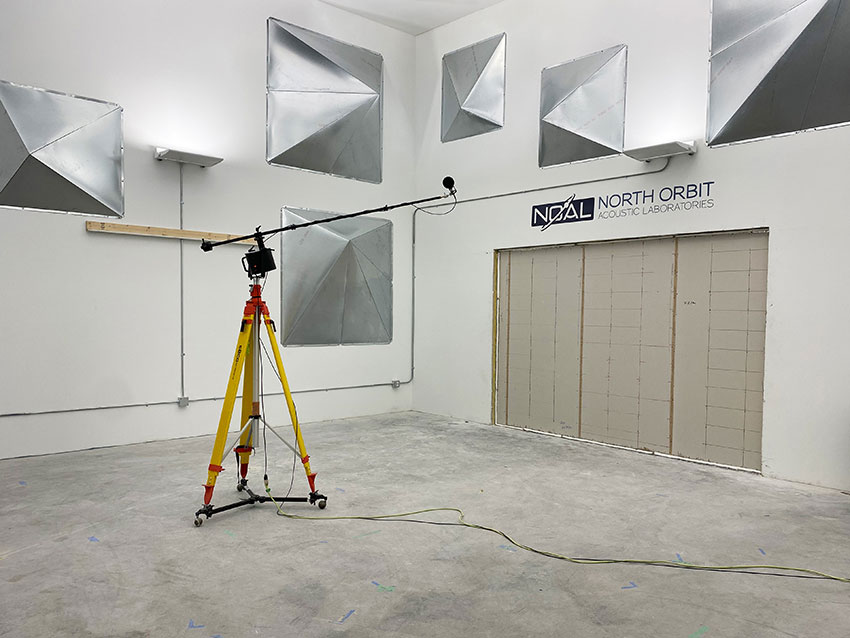
Photo courtesy of PABCO® Gypsum
CLD gypsum panels are tested in a third-party-accredited laboratory using various assemblies to determine their sound-reducing qualities and compliance with performance standards.
Types of CLD Panels
Just like other gypsum products, CLD panels can be manufactured to meet or exceed other building code requirements. CLD panels have been tested in a number of different types of assemblies to provide different fire-resistant-rated partitions that can be used to satisfy building code requirements.
Some project applications require mold-resistant drywall panels. CLD panels can be manufactured to meet these requirements as well using special formulations for both the core and paper facings. Typically, mold-resistant CLD panels are available in thicknesses of ½” for use in non-fire-resistance-rated partitions and 5/8” Type X for use in rated assemblies. For circumstances that warrant it, there is also sound reducing drywall that can resist impact and abuse.
Ease of Installation
Field installed products are often only as good as their ability to be installed properly. CLD panels offer some specific advantages when it comes to installation. First, there may be fewer layers of drywall to install – STC ratings can be achieved with a single CLD panel instead of multiple layers of drywall. That saves installation time, reduces action steps, and helps control labor costs. Second, at least one manufacturer has developed panels that allow installers the ability to easily score, snap, and install the drywall just like standard gypsum wall panels since there is no paper or metal in the center of the panel. Overall, the drywall delivers high acoustic performance with improved workability to speed up installation time.
Related Products
In order to achieve the best performance using CLD or any acoustic treatment, the penetrations and perimeter of the walls need to be addressed. Typically, this means acoustical sealants need to be applied to the perimeter of the wall and acoustical putty to the penetrations.
With the wide variety of building types and possible applications, it is recommended to work with a manufacturer and an acoustic consultant early in the design process to determine the best and most cost-effective products for any given project. It is also best to work with manufacturers that bring a depth of technical knowledge, independent testing results, and a willingness to share the data with the design professionals who request it. At least one company has conducted more than 1,000 ASTM E90 Sound Transmission Loss (STL) tests with varying framing and panel configurations. This level of testing and analysis on building noise control is rare but valuable to supporting the design professions and the building construction industry.
Cost-Effectiveness
A comparison of CLD panels contrasted with other typical interior partition assemblies reveals the nature of their cost effectiveness. As shown in the following chart, an assembly with a CLD panel on one side and a Type X gypsum panel on the other is installed over standard 33 mil metal studs with insulation between the studs. This assembly has been tested and shown to achieve a sound rating of STC-51. Pricing out this assembly using conventional pricing data (based on RS Means Construction Data – national average) shows a calculated material cost of $3.71 per foot, a labor cost of $4.34, and a total of $8.05 per square foot.
By comparison, a similar assembly is shown in the chart which uses a single layer of Type X drywall on each side of insulated metal studs but with one side receiving a resilient channel. This assembly has been documented to produce a slightly lower STC-50. The cost for this assembly is a bit less for materials at $2.94 but notably more for labor at $6.97 totaling $9.91 per square foot or about 23 percent more than the CLD assembly.
Similarly, using 2 layers of Type X drywall on either side of the same insulated metal studs also produces a documented slightly lower STC-50 rating. The cost for this assembly includes materials at a mid-point of $3.10 but notable labor cost of $5.68 totaling $8.78 which is still over 9 percent more than the CLD assembly. Multiplying this level of savings across an entire building quickly adds up to noticeable cost savings, all while achieving a superior acoustical performance.
Deanna Crossman is the owner of The Mayton Inn, a luxury boutique hotel in Cary, North Carolina. She reflects on a recent project there: “We were targeting an STC of 62-65 in the guest rooms and the performance exceeded our expectations. We found CLD sound-reducing gypsum panels to be a cost-effective part of our strategy. It was the perfect balance between material cost vs. the labor savings in installation."
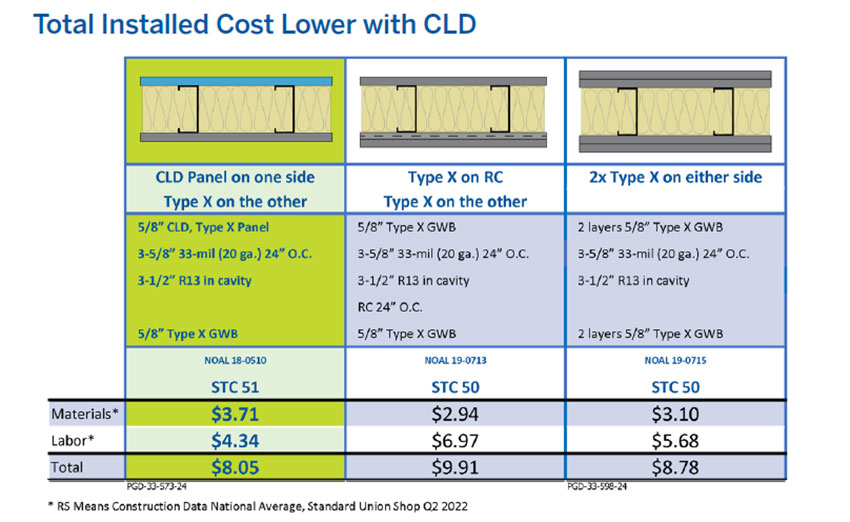
Image courtesy of PABCO® Gypsum

Photo courtesy of Construction Specialties, Inc.
Acoustical architectural louvers can be designed to fit into a building and provide noise reduction where it is needed.
Acoustical Architectural Louvers
Louvers are used on commercial buildings to ventilate a space for HVAC equipment, either for exhaust ventilation or for air intake ventilation. The walls and space where those louvers are located may also have some acoustical requirements to keep outside noise out or inside noise in. This could be an application where normal HVAC mechanical equipment is functioning or one in which a backup generator is in close proximity to an occupied space. In those cases, acoustical architectural louvers are the best choice to minimize sound without losing ventilation. Acoustical louvers provide protection from water penetration and good airflow performance.
Acoustical architectural louvers are typically used whenever sound attenuation or minimizing noise is essential to the project. They may also be specified whenever it is necessary to reduce sound levels from noise that escapes from exterior or interior walls. Depending on the relative priority of the noise reduction compared to the airflow needed, manufacturers offer different makes and models of acoustical architectural louvers to suit different performance needs including varying depths and air and water performance.
Acoustical architectural louvers are typically solid louvers that are filled with fiberglass insulation that provides a noise reduction (NR) between 14 and 23 depending on the frequency of the sound. In this way, they can reduce the level of sound entering or leaving the building or passing to spaces within a structure.
Some other considerations of selecting acoustical architectural louvers include the following.
- Aesthetics. Whether the design intent is for a louver to be a major design element or simply disappear into the facade of the building, there are numerous aesthetic options to choose from. Louver systems are available that provide designers with a full palette of textures, the option of a wood grain appearance, and an almost unlimited range of finish color options.
- Testing. Knowing how a louver will perform is critical to ensuring that it will stand up to real-life conditions in the finished project. Manufacturers should be able to verify how their products perform based on independent testing to the louver standards provided by the Air Movement and Control Association (AMCA). These standardized tests address air performance, acoustic sound attenuation, still air water penetration and wind-driven rain. Some manufacturers can also provide custom air/water testing using their own on-site test chamber to address specific concerns related to custom applications which are not testable by AMCA. This can often be a concern when curtain wall construction is employed, and water penetration needs to be fully controlled.
- Airflow Calculations. In order to predict the airflow performance of architectural louvers, manufacturers may offer an online tool allowing design professionals to enter design parameters and determine the performance of selected louver products at a given size. The input information includes the designed width and height of a louver, the design wind load, and the selected louver. If applicable, HVAC fan information can also be entered in the form of cubic feet per minute (CFM) intake or exhaust. The program will then calculate and provide the results related to free area square feet and percentage, the free area air velocity, and tested pressure drop. There is also the opportunity to connect with manufacturer’s technical teams to review any or all of these aspects of acoustical louver design to confirm the total performance in a building project.
ACOUSTICAL CURTAINS
There are some situations where a solid wall is not appropriate, but acoustical control is still needed. A good example is in healthcare settings where a group of patients need to be in close proximity of each other to receive appropriate care, but still need their privacy protected. Surgical pre-op spaces need to protect patient confidentiality, outpatient surgery centers need acoustically private doctor consult areas before surgery, and patients need quiet areas for recovery post-op. That privacy is not only to help with their sense of comfort in the space but also to comply with the federal HIPAA requirements which all healthcare facilities must meet.
In such cases, long curtains are commonly hung on ceiling tracks to provide privacy but also so they can be opened to roll beds with patients in or out of the enclosed space or simply to tend readily to their care when needed. When those curtains are designed and manufactured with acoustical properties, then they can achieve the seemingly paradoxical goals of access plus privacy. Beyond healthcare, such acoustical curtains can be used in any building where a privacy setting is required such as hair salons, mother rooms in office buildings, or spaces that need to adapt fast to provide separated rooms or areas. Overhead tracks with privacy sound absorption curtains can easily be installed to provide those spaces with the acoustical privacy that may be needed.
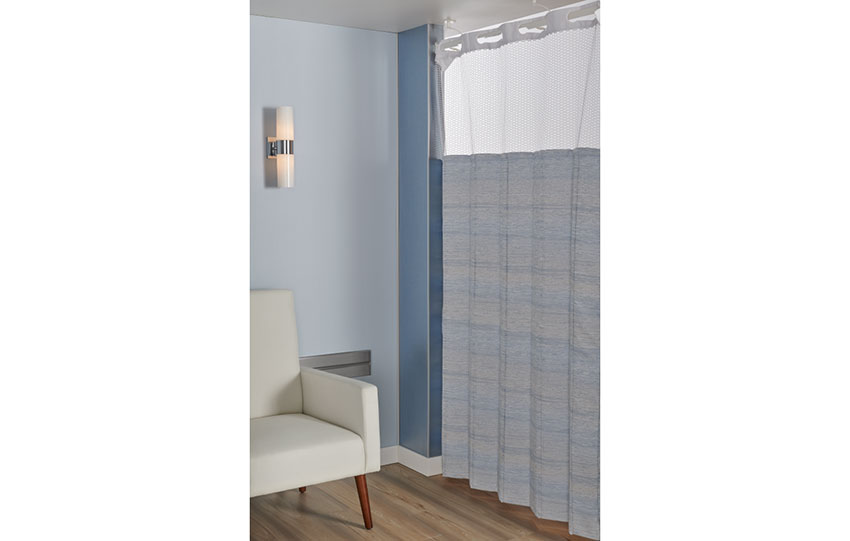
Photo courtesy of Construction Specialties, Inc.
Acoustical curtains provide a design solution for needed access to an enclosable space while offering much improved acoustical privacy.
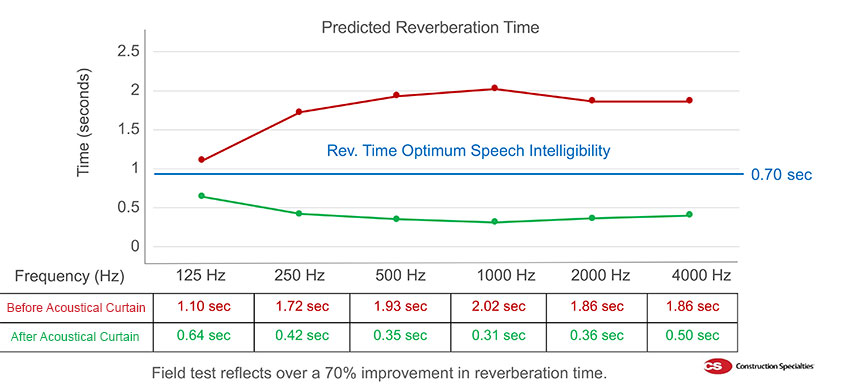
Image courtesy of Construction Specialties, Inc.
Field test reflects over a 70 percent improvement in reverberation comparing before the acoustical curtain was installed with after the installation.
Field test reflects over a 70 percent improvement in reverberation comparing before the acoustical curtain was installed with after the installation.
The means for acoustical privacy curtains to achieve their sound attenuation performance is a direct result of the way they are made. The curtains are essentially panels of fabrics that allow for absorptive inserts to be incorporated into them. This produces a noise reduction coefficient (NRC) of 0.95 and an STC of 11. Essentially these results are achieved by the panels blocking and absorbing sound by slowing the reflective velocity of the sound.
One of the benefits of these acoustic curtains is that they require virtually no extra space. Further, since they are double sided, more acoustical materials can be installed to suit different acoustical privacy needs. Their simplicity makes them appropriate for new construction or for retrofit/ renovation projects with no significant disruption in the use of the space. Their acoustic performance has been tested and some carry documentation that they are capable of aiding in patient privacy and HIPAA compliance. The panels are available in a wide range of fabrics with many different colors and patterns, which can also provide a visual setting that helps elevate patient spirits.
Jason Ellis, senior business manager of interior product solutions at Construction Specialties has reviewed some of the documentation and testing of these acoustical curtains. He observes, “Tested by third-party scientists, the acoustical curtain, when installed, showed a seventy percent improvement in reverberation time. It provides privacy by incorporating acoustical panels that help absorb sound that softens and muffles noise by slowing the reflective velocity within a space.”
Conclusion
Architects and designers are well served when they take time in the design process to consider the acoustical needs of the building occupants. Addressing the entire spectrum of sound control within individual rooms and spaces in a holistic or comprehensive manner will assure the best performance. By addressing the sound absorption, reflection, and transmission in a given room, the appropriate sound qualities can become part of a successful acoustic design. Overall, this holistic, coordinated approach will yield a design that creates a very positive contribution to the total indoor environmental experience of the building.
Peter J. Arsenault, FAIA, NCARB, LEED AP is a nationally known architect and a prolific author advancing positive acoustical experiences through better building design. www.pjaarch.com, www.linkedin.com/in/pjaarch













